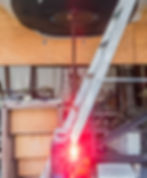We had a very, very close look at our keel design during development. In production we are removing all possible failures by a dedicated quality management.
A bulb on a long, thin keel fin produces a lot of load at the area of the transition into the hull. We are using continuous, unbended, stretched fibers to avoid weak areas. Due to the fiber orientation a carbon prepreg fin can carry far more load than steel fin and has less fatigue. Our fibers are stretched from the keel head around the bulb in direction of the forces. No screws, no welding, no material mix. This production methods reduces the possibilities for faults and increase the safety.
Design & Engineering
- the engineering is done by one of the best structural composite engineering office in the world.
- we are using only carbon/epoxy prepregs for the structural parts
- the laminate in the fin is oversized, especially in the hull and bulb junctions
- the keel head is a big as possible
- we decided to have a bigger fin for more strength and comfortable maneuvering at lower speeds
- the hull in the keel area is 27mm massive laminate

Analysis of forces by Finite Elemente Method. The area is divided into finitely many subdomains of simple form, e.g. into many small cuboids or tetrahedra. They are the "finite elements". Due to their simple geometry, their physical behaviour can be calculated well with known starting functions. The physical behaviour of the entire body is simulated by how these elements react to the forces, loads and boundary conditions and how the loads and reactions propagate from one element to the next through very specific problem-dependent continuity conditions that must be fulfilled by the initial functions.


The keel case is supported by 2 huge bulkheads and massive longitudinals. Due to the large keel box (compared to other boats), the forces that occur are much smaller and can be better absorbed or transferred into the hull structure via the huge bulklheads and longitudinal stringers.
Production
- we are a highly skilled team, the best of us working at the keel and structure
- we have tested our laminates in our laboratory
- the keel production is monitored by an dedicated quality manager
- all production steps are recorded in our quality management system
- the quality system is ISO 9001:2015 accreditated by German TÜV's third party verification
- we have a dedicated keel alignment process

Dedicated keel alignment process. We have zero tolerance in the keel box, because the keel wedges are produced in the dedicated boat and keel. Due to that we avoid additional forces by a shaking keel.
Handling safety
- the keel is be mounted with a self aligning head wedge
- if the keel bolt breaks, the keel can not fall out

The carbon keel wedge on the keel head prevents the keel from falling down and is self-adjusting due to the trapeze wedge shape. Even loose bolts can not fall out. In the photo the keel is lifted up and the boat is in the trailer.
Our quality standards:
Classed as a racing boat up to a crew of 6, Class B rules to be followed. With 4 crew Class A rules to be followed. For design and design pressures, ISO 12215-5, Design category A rules will be followed, means upgrade to OSR Category 1 is possible.
ISO 12215-1 Laminate and adhesive material properties 2000
ISO 12215-2 Core material properties 2002-
ISO 12215-5 Design pressures, stresses, scantlings 2019
ISO 12215-8 Rudders 2012
ISO 12215-9 Appendages 2012
ISO 12215-10 Rig loads and rig attachments 2020
EC Certification KAT A/B, SWISS LLOYD
EN ISP 12212-2 Stability
EN ISO 11812 water pump out, waterproofness
EN ISO 12216 Windows, doors, openings
EN ISO 14945, 14946 badge, payloads
EN ISO 20240 skipper manual
the result
Category A:
PAX: 4
Payload: 445 kg (In double handed mode there is an additional buffer of 445 kg payload)
STIX: 34 (Minimum requirement für Cat A 32)
Category B:
PAX: 6
Payload: 635 kg
STIX: 34 (Minimum requirement für Cat B 23)
With diesel inboard engine (appr. +250kg with fuel)
Category A:
PAX: 4
Payload: 445 kg (In double handed mode there is an additional buffer of 445 kg payload)
STIX: 36 (Minimum requirement für Cat A 32)
World Sailing Offshore Special Regulations 2019 (check here >>).
Our partners:
- certification: http://www.i-yacht.de/
- Hull production: https://novacomposites.com/
- Prepregs: https://www.notuscomposites.com
Why a Carbon keel fin?
Here are some typical production methods of keels and their weak points.
welded steel fin with glassfiber cover - danger of corrosion at the bulb/fin connection
- danger of fatigue of keel bolts
- experienced welder necessary
- quality control of steel grade and welding necessary
forged milled steel fin - danger of corrosion at the bulb/fin connection
- danger of fatigue of keel bolts
- very expensive
casted steel fin - danger of corrosion at the bulb/fin connection
- danger of fatigue of keel bolts
- danger of fatigue of the casted material
- quality control of steel grade casting process necessary
carbon fin with integrated bulb - experienced laminators necessary
We have very experienced laminators and our own material quality management. For us it´s far more easy to produce a good carbon fin than a steel fin.

Material testing.
